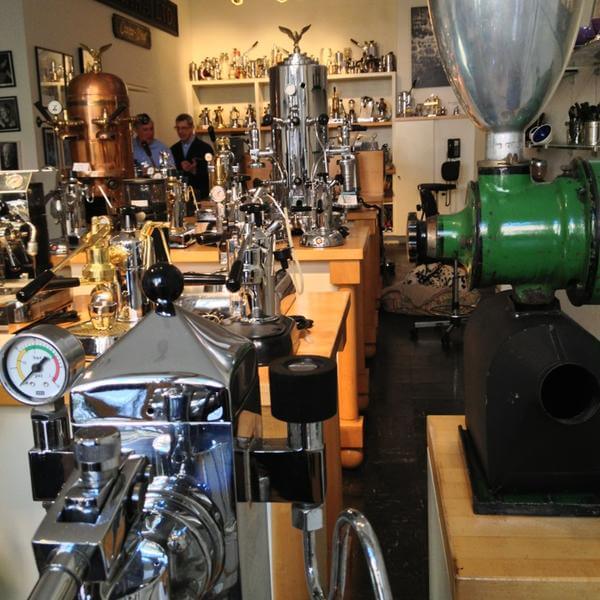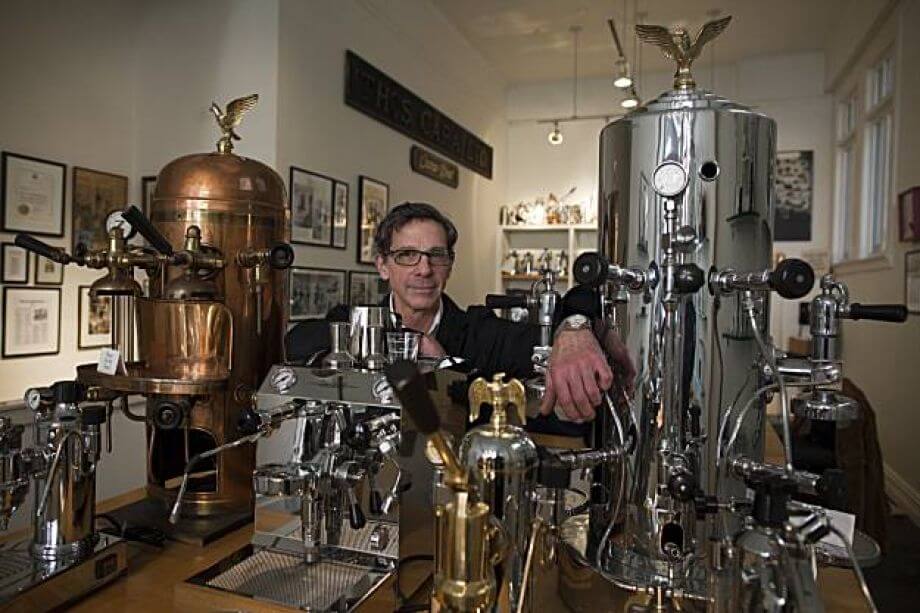How I brought the first domestic espresso maker to Hollywood
It was 1954. I was a curator at the San Francisco Museum of Art assisting Frank Stauffacher, a filmmaker and critic, who ran a series of programs at the Museum highlighting the creative achievements of Hollywood directors. This was clearly an avant-garde recognition of Hollywood directors as auteurs. Among those whom Frank selected were: George Stevens, Vincent Minnelli, Rouben Mamoulian and Fred Zinnemann. Each director was invited to come to San Francisco to show selections from his films, comment on them and answer questions from the audience. Why would Hollywood giants come to San Francisco for nothing but a free plane ticket? Through his Art in Cinema series at the Museum, Frank had developed a very sophisticated ï¬lm audience. Art in Cinema presented a melange of avant-garde, classics and documentaries. There was nothing else like it anywhere in the country at that time. The Museum of Modern Art in New York had its Film Library collection which managed to place films on a par with paintings and sculpture. There were regular showings in the Museum’s basement theater and duplicate prints of some films were lent to ï¬lm societies around the country. The focus of MOMA at that time (1950s) was to acquaint American audiences with the history of modern art from the beginning of the twentieth century. In doing that, the Museum presented modern art in a context broader than painting, sculpture and printmaking. Architecture, graphic design and films were among its expanded scope. Thus, D.W. Griffith and Claude Renoir fell within its purvey, but Hollywood was off limits.
Having been given the responsibility of contacting Rouben Mamoulian as a possible speaker for the Art in Cinema directors’ series, I went from San Francisco to Los Angeles and was invited to meet him at his home. Mamoulian was a highly successful ï¬lm and theater director. Typical of many directors of his era, he was a cosmopolitan European. Born in Tbilisi, Georgia, of Armenian descent, he was the son of a bank president; he spent part of his childhood in Paris and later studied at the Moscow Art Theatre. He arrived in America in 1923, later making a name for himself as the director of lavish Broadway productions including George Gershwin’s operatic version of Porgy and Bess as well as Rodgers and Hammerstein’s Oklahoma. Migrating between Hollywood and Broadway, he developed a reputation for lavish ï¬lm productions rich in color, costumes, decor and music — among them Blood and Sand (1941) with Tyrone Power, Linda Darnell and Rita Hayworth.
We met in his grandiose living room, which could have been the set of one of his films. When we concluded our negotiations with his agreeing to come to San Francisco, conversation shifted to more mundane topics. His wife was present throughout our discussions. At this point, Mamoulian was in his late fifties; she appeared to be in her forties with an untortured body and bleached blonde hair. She and I seemed to hit it off. We shared a passion for things Italian, discussing food, wine and coffee. I told her of an Italian domestic espresso machine that I had just purchased from Thomas Cara in San Francisco’s North Beach. He was a pioneer introducing Italian espresso machines to this country. As our discussion and shared nostalgia for real Italian espresso became more passionate, I offered to send her one of Thomas Cara’s Italian domestic espresso machines. (Incidentally, I still have mine and use it.)
Can I prove that Mrs. Mamoulilian’s espresso machine was the first to land in Hollywood? I doubt it, but I can assume that if there had been others available in the circles in which the Mamoulians traveled, she would have known about it. These simple cast aluminum contraptions were placed directly over the burner with chambers filled with coffee and water and heated to the point at which espresso gushed out of the coffee chamber into the waiting pot sitting below. Espresso makers have become more elaborate and complicated in recent years, when I was in Rome a few months ago, I saw variations of this espresso maker in housewares stores.
As a final note, a brief history of espresso coffee makers is in order. In 1901, Luigi Bezzera patented the world’s first espresso machine, a gigantic steam powered device that served as the prototype for commercial espresso makers for generations. In 1947, the espresso revolution began with the Gaggia Crema Caffee machine which made espresso a generally affordable commodity.
I wonder if the Mamoulian’s heirs treasure their 1950s vintage espresso maker the way that I do mine.
For more information about the history of Italian domestic and commercial espresso makers, check out these links:
• Homespresso, 1900-1970 Immagini della Collezione
• An Espresso Century, an exhibition 30 of the most important commercial espresso coffee makers that has been traveling internationally since 2000.


